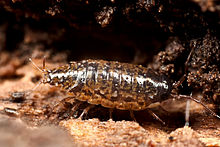| Ligidium hypnorum | |
|---|---|

| |
| Scientific classification | |
| Domain: | Eukaryota |
| Kingdom: | Animalia |
| Phylum: | Arthropoda |
| Class: | Malacostraca |
| Order: | Isopoda |
| Suborder: | Oniscidea |
| Family: | Ligiidae |
| Genus: | Ligidium |
| Species: | L. hypnorum |
| Binomial name | |
| Ligidium hypnorum (Cuvier, 1792) | |
| Synonyms | |
| |
Ligidium hypnorum is a species of woodlouse found across Europe and western Asia. It is a fast-moving, active species that rarely grows longer than 9 mm (0.35 in). It is dark and shiny, and is similar in appearance to the common species Philoscia muscorum, and also the rarer Oritoniscus flavus. In Great Britain, it was first discovered at Copthorne Common, Surrey, in 1873, and most later records are also from South East England. It is considered a good indicator species for ancient woodland.
Disease
Prior to the recognition of Invertebrate iridescent virus 31 (IIV-31) in 1980, blue individuals of L. hypnorum had been discovered, which were interpreted to be new subspecies, and were described as such: L. hypnorum coeruleum Lereboullet 1843 and L. hypnorum amethystinum Schöbl 1861 (in reference to cerulean and amethyst, respectively). These cases have since been reinterpreted, not as distinct taxonomic entities, but as historical findings of individuals infected with IIV-31.
See also
References
- ^ Helmut Schmalfuss (2003). "World catalog of terrestrial isopods (Isopoda: Oniscidea) — revised and updated version" (PDF). Stuttgarter Beiträge zur Naturkunde, Serie A. 654: 341 pp.
- ^ Paul T. Harding & Stephen L. Sutton (1985). Woodlice in Britain and Ireland: distribution and habitat (PDF). Abbots Ripton, Huntingdon, Institute of Terrestrial Ecology. p. 151. ISBN 0-904282-85-6. accessed through the NERC Open Access Research Archive (NORA)
- Earthwatch Institute (February 19, 2009). "One year in the woods - the Earthwatch Regional Climate Centre at Wytham Woods, Oxford".
- Poinar, George O.; Hess, Roberta T.; Stock, Jan H. (1985-01-01). "Occurrence of the Isopod Iridovirus in European Armadillidium and Porcellio (Crustacea, Isopoda)". Bijdragen tot de Dierkunde (in Dutch). 55 (2): 280–282. doi:10.1163/26660644-05502007. ISSN 0067-8546.
External links
 Media related to Ligidium hypnorum at Wikimedia Commons
Media related to Ligidium hypnorum at Wikimedia Commons
| Taxon identifiers | |
|---|---|
| Ligidium hypnorum | |
| Oniscus hypnorum | |
This isopod-related article is a stub. You can help Misplaced Pages by expanding it. |